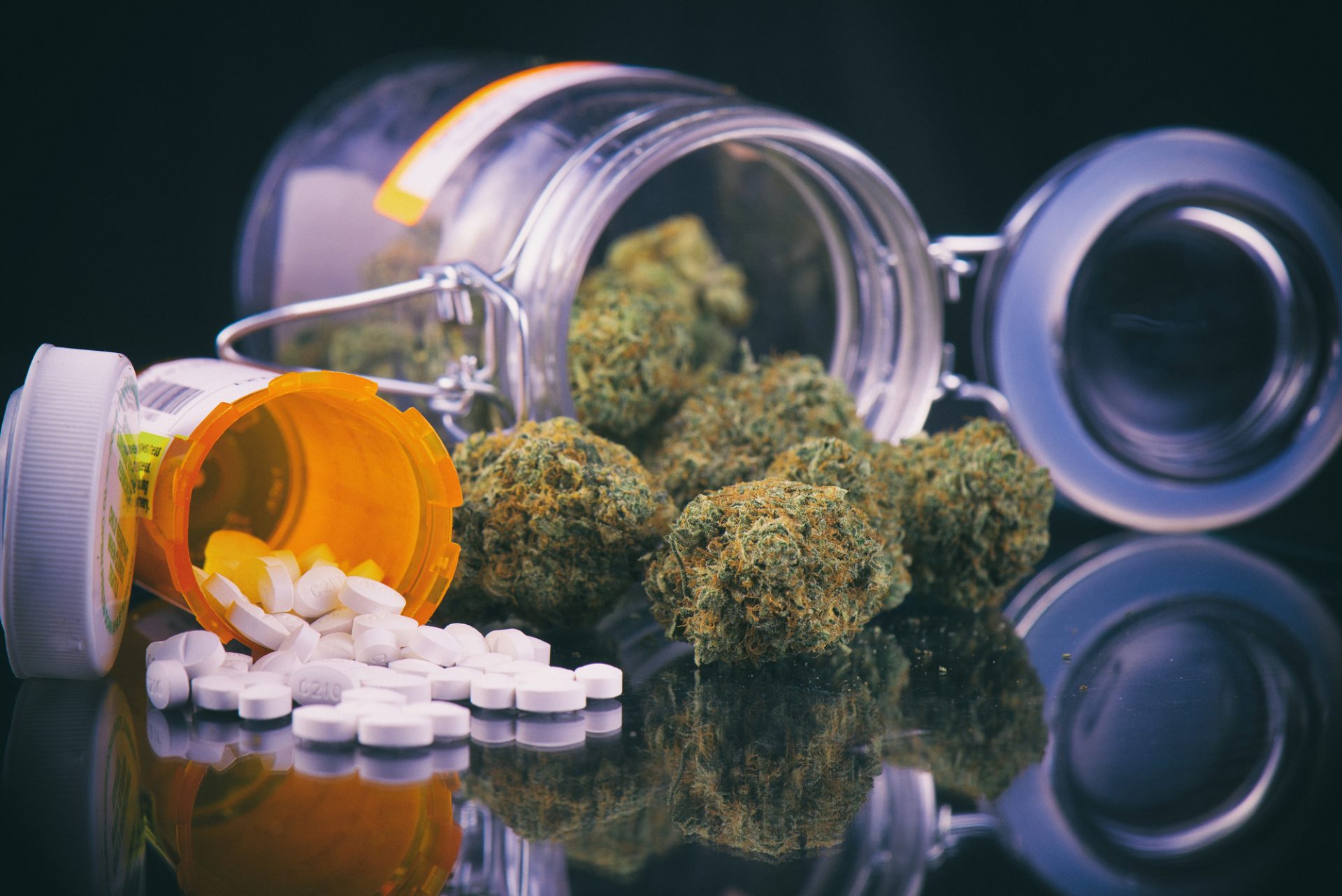Medical cannabis is a wonderful thing. It helps people deal with depression and PTSD; aids in management of nausea, anorexia, and other appetite issues; is beneficial for patients with Alzheimer’s, Parkinson’s, and MS; it’s effective for chronic and acute pain management as well. Although cannabis and drug interactions aren’t very common, it is important to know that they can occur.
While many people find they are able to stop taking at least some of their medications once they start using MMJ, there are certain drugs that may need to be continued or slowly tapered down. This may present a risk of interaction between these medications and cannabis. While the list of known side effects is short, they can be significant and need to be understood by both the physician and the patient. Extra monitoring may need to take place to assure the best possible outcome and to minimize adverse reactions.
Drug Interactions
Every substance on the planet interacts with other substances. The amount and severity of reactions, negative or positive, often depend on the person as well as on the substance itself. Factors affecting interactions include diet, activity level, other medications, general health of the patient, stressors, and environmental considerations. Each thing you put in or on your body has the potential to react to everything else you use or ingest. Some of these interactions are well known and can generally be applied to the population as a whole, while others are specific to a disease process, medication, or particular segments of the population. For example, grapefruit juice can affect the metabolism of medication by influencing the enzymes that break it down. This can lead to an increased concentration of the substance in the bloodstream, which can cause harmful or even toxic effects.
Most drugs have a minimal interaction with cannabis. However, there are exceptions. Being aware of these possibilities can make a big difference in how you utilize cannabis as well as what to watch out for in your own personal situation. Listed below are some substances that have the potential to cause unwanted effects. Because of the Schedule I status of marijuana, research in this area is still in its infancy. Early results only show a few medications affected by routine cannabis use; this list may grow as time passes and we learn more about the benefits and drawbacks of using cannabis with other substances.
Alcohol
People who use alcohol can experience one of two possible types of interactions with cannabis:
- Alcohol has the potential to increase the level of THC in your blood, leading to an increased buzz or sensation of being high. It’s interesting to note that the reverse hasn’t been found to be true; THC doesn’t increase blood alcohol levels, according to current research.
- A relatively recent study found that people who concurrently drink alcohol and consume cannabis may find they don’t drink as much as if they’re not using marijuana. While the study was limited, the findings indicate that if you’re doing both, you may use more cannabis while drinking less. In fact, ¾ of the people in this study consumed significantly less alcohol when they were also using cannabis than if they were just drinking.
It is very important to note that one of the positive side effects of cannabis, a decrease in nausea and vomiting, can be detrimental if you are drinking and using marijuana. If you drink too much, you may experience nausea and/or vomiting as your body tries to expel some of the toxins in the alcohol in an attempt to lower your blood alcohol level. Ingesting enough cannabis to inhibit this reaction can cause alcohol toxicity.
Finally, as dangerous as it is to drink and drive, it is even more dangerous to drive after mixing cannabis and alcohol. Caution should be used should you choose to participate in this kind of activity in order to keep yourself and everyone else safe.
Non-prescription Opioids
I’ve met several people who have used cannabis to successfully wean themselves off non-prescription or illegal opioids. There have been studies done on rats and monkeys that show when these animals are given a regular dose of THC, their self-administration of heroin decreases in over 75% of subjects. This is important considering the current opioid crisis in the USA. Giving addicts hope that they can decrease and possibly even stop using illicit and potentially very dangerous substances is a crucial part of helping them overcome their addictions.
Medications That Affect Calcium Levels
THC and CBD can cause elevated cellular calcium levels. Patients taking medications such as parathyroid hormone, calcium, or vitamin D need to let their doctors know they are using cannabis in order to prevent hypercalcemia, which can cause nausea, vomiting, increased urination, and weakness; it can also lead to the formation of kidney stones.
Drugs Influencing Blood Sugar Levels
Cannabis can help decrease blood sugar levels, improve blood sugar control, and aid in metabolism. There have been studies showing that cannabis users had lower rates of diabetes and obesity than non-users. While more research needs to be done, it is possible that marijuana can be used to help diabetic patients keep their sugars under control.
Blood Pressure Medications
THC stimulates both CB1 & CB2 receptors, which are also affected by medications used to help control blood pressure. Cannabis users may be at risk of increased negative side effects of these medications, including but not limited to decreased coronary arterial blood flow and increased cardiac oxygen use. It’s important to let your physician know if you are using cannabis while on these meds so they can monitor you more closely for potential complications. Beta blockers such as Tenormin and Toprol are included in this category.
Drugs That May Increase the Risk of Bleeding
Cannabis can slow the metabolism and excretion of drugs specifically used to prevent the formation of blood clots, like warfarin or heparin. Also included in this category are medications that can cause bleeding as part of their side effects – these include naproxen and ibuprofen as well as other NSAIDS.
Prescription Opioids
In a small study, it was discovered that chronic pain patients who also used cannabis experienced up to 27% less pain than if they just took the drugs prescribed for their pain. As an adjunct to opioid therapy, marijuana can provide increased efficacy of the prescription drug, thereby possibly enabling the patient to decrease opioid dependency and lessen the side effects of these medications.
In addition, cannabis can be used as a first-line pain medication alternative to opioid therapy. It has less potential for toxic effects and the possibility for dependence, making it a viable alternative for many patients. In light of the current opioid crisis, using marijuana for pain relief can prove extremely beneficial as well as decreasing the risk of chronic pain patients resorting to illegal and possibly very dangerous street drugs when they can’t get prescription pain medication.
Sedatives
- Suboxone or Buprenex is used for pain control as well as treating addiction. It is a central nervous system depressant and can cause respiratory distress, coma, or even death when abused. This medication, if combined with cannabis, can lead to slowed or slurred speech, excessive sedation, difficulty controlling motor function, and a slow/irregular heartbeat.
- Other substances such as benzodiazepines, barbiturates, and codeine can interact with certain terpenes in cannabis, producing the same kind of effects. It is best to avoid combining these drugs if at all possible; exercise extreme caution if using these medications with cannabis to avoid a negative outcome.
Macrolide Antibiotics
Erythromycin and azithromycin are examples of macrolide antibiotics. They work by inhibiting a cytochrome known as P450. This is the same cytochrome that processes CBD, which presents a problem if you’re using the two substances together because if the body is busy processing the CBD, it can’t effectively metabolize these antibiotics. The end result could potentially be an increase in both the level of antibiotics and THC in the blood, which could interfere with the effectiveness of the antibiotic as well as the potential for increased nausea and other gastric symptoms related to antibiotic therapy.
Retrovirals for HIV
Because these drugs are processed by the P450 cytochrome, using cannabis while taking them can increase the levels of both substances in the blood as they compete to be metabolized and excreted from the body. The effects of CBD as well as the side effects of the drugs can be intensified; it is recommended that a patient new to CBD start with a very low dose and build up slowly if they are on retroviral drugs in order to generally increase tolerance and lessen the chance for negative side effects.
Anticonvulsant Drugs
Clobazam is an anti-seizure drug that may interact with CBD, resulting in increased levels of the medication in the bloodstream. This can cause fatigue, tiredness, and increased sedation.
Antipsychotics
When combined with cannabis, Risperidone may react negatively. This can lead to increased levels of the drug in the bloodstream, causing anxiety attacks. Antipsychotics are also used as tranquilizers for patients with hallucinations, delusions and psychotic episodes; because they compete for that same P450 cytochrome for metabolism, the CBD in cannabis and the drugs can essentially cancel each other out, leading to a loss of efficacy for the medication. Patients may need to be more closely monitored by their physician if they are using these drugs together.
Antidepressants
While negative interactions between cannabis and antidepressants are rare, patients taking SSRI drugs such as Prozac should be made aware that there is an increased risk of hypomania when taking the two substances concurrently. That being said, many patients who use medicinal marijuana are able to wean themselves off antidepressant therapy by using CBD.
Narcolepsy Medication
Xyrem is a drug used to treat excessive sleepiness in the daytime. Combining this drug with cannabis can result in drowsiness, lightheadedness, dizziness, impairment in thinking and motor coordination, confusion, depression, slowed breathing, low blood pressure, and even coma or death. Close monitoring is essential if you are taking this drug and cannabis at the same time.
Steroids
Taking cannabis with steroids such as estrogen, testosterone, and hydrocortisone can increase their levels in the bloodstream since they also depend on the P450 cytochrome for metabolism.
Conclusion
It’s important to note a few things at this point.
- Research into cannabis/drug interactions is just beginning. While it is possible that there may be more severe reactions to certain kinds of medication, early indicators suggest cannabis has far fewer interactions than most other substances. Because cannabis is not a single compound but one that varies by strain, region, and growing conditions, it is almost impossible to say that combining it with a specific drug will have a specific effect. However, it appears to be far better tolerated than many drugs; it also has far fewer negative side effects and interactions.
- One of the most compelling arguments for medical cannabis use is that it can treat many conditions at once, lessening or eliminating the need for multiple prescriptions – some of which may react negatively with each other.
- Most potential interactions or negative effects arising from the combination of cannabis and prescription medications are mild, especially compared with other substances. In addition, marijuana seems to enhance the therapeutic effects of several classes of drugs. It can also be used to help treat addiction to stronger, more dangerous opioids.
Using cannabis responsibly can improve your life, help your medications work better, and even enable you to eliminate some of the prescription bottles in your medicine cabinet.
When compared to caffeine, which has 82 identified drug interactions (25 of which are moderately severe or severe in nature), cannabis seems almost benign. Just like any other medication, though, it is important for us to be aware of potential side effects, monitor for those problems, and notify our physicians if we are taking any drugs that have the possibility to interact negatively with THC/CBD.




